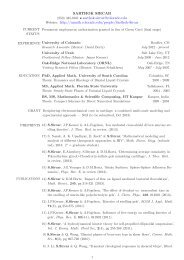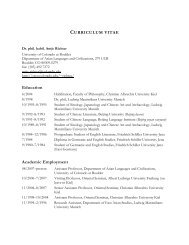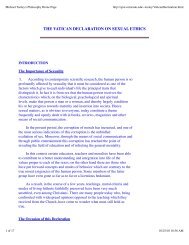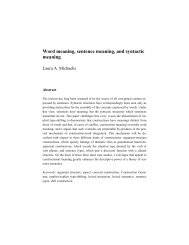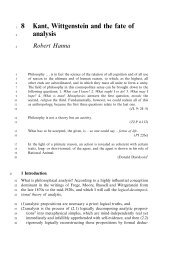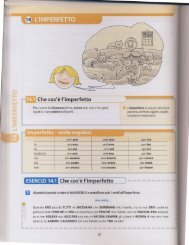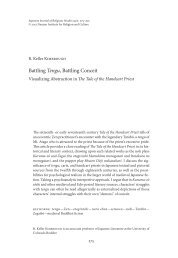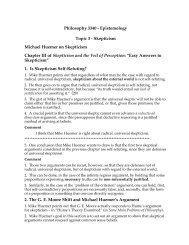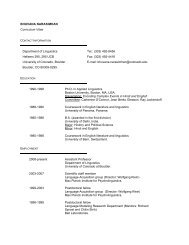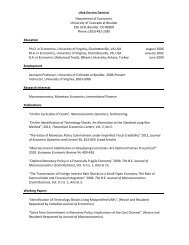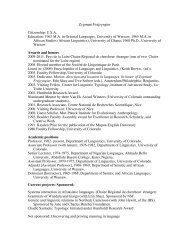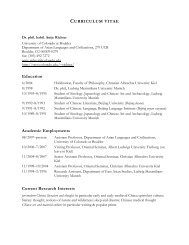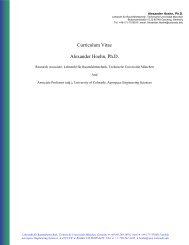The Treaty of Verdun (843)
The Treaty of Verdun (843)
The Treaty of Verdun (843)
Create successful ePaper yourself
Turn your PDF publications into a flip-book with our unique Google optimized e-Paper software.
<strong>The</strong> <strong>Treaty</strong> <strong>of</strong> <strong>Verdun</strong> (<strong>843</strong>)
<strong>The</strong> Kingdom <strong>of</strong> the Franks Under Hugh Capet (r. 987-996).
Europe Around 1050 A.D.
<strong>The</strong> German Empire in the Eleventh Century
Germany and the Holy Roman Empire<br />
German Stem-Duchies: Swabia, Bavaria, Saxony, Franconia and Carinthia<br />
Electoral Kingship = 919, Henry, Duke <strong>of</strong> Saxony, elected as King<br />
Ottonian Dynasty: Otto I (r. 936-973) – in 962, crowned Emperor by the<br />
Pope = rules the Holy Roman Empire<br />
Eigenkirchen = personal churches controlled by laymen, many controlled by<br />
Ottonian kings = Bishops and abbots came to act as royal <strong>of</strong>ficials<br />
German Kingship was Sacral Kingship<br />
- Anointed kings<br />
- King’s two bodies: one divine, one corporeal<br />
- Laudes Regiae = praises <strong>of</strong> the king
Ivory carving (book-cover) Christ crowning Otto II and <strong>The</strong>ophano – Otto III later styled<br />
himself “servant <strong>of</strong> the servants <strong>of</strong> God,” and “vicar <strong>of</strong> Christ”<br />
(late 11 th century)
<strong>The</strong> Reform <strong>of</strong> the Church in the Eleventh Century<br />
Reform Agenda<br />
1) Simony = purchasing church <strong>of</strong>fices<br />
2) Clerical Marriage and Concubinage = Celibacy<br />
3) Lay Investiture = right to invest or bestow a church <strong>of</strong>fice<br />
Broader Reform Ideals<br />
Liberty <strong>of</strong> the Church = Libertas Ecclesiae<br />
Papal Primacy – supreme authority <strong>of</strong> the Popes<br />
Pope Leo IX (r. 1049-1054)<br />
Peter Damian (chronicler reformer)<br />
Matilda <strong>of</strong> Tuscany (Duchess and magnate <strong>of</strong> Northern Italy)<br />
Hildebrando (monk reformer) = Pope Gregory VII (r. 1073-85)
St. Peter casts down Simon Magus who asked to buy the gift <strong>of</strong> the Holy Spirit<br />
(episode in Acts 8:18-24) Capital from Autun Cathedral, ca. 12 th century.
<strong>The</strong> Reform <strong>of</strong> the Church in the Eleventh Century<br />
Reform Agenda<br />
1) Simony = purchasing church <strong>of</strong>fices<br />
2) Clerical Marriage and Concubinage = Celibacy<br />
3) Lay Investiture = right to invest or bestow a church <strong>of</strong>fice<br />
Broader Reform Ideals<br />
Liberty <strong>of</strong> the Church = Libertas Ecclesiae<br />
Papal Primacy – supreme authority <strong>of</strong> the Popes<br />
Pope Leo IX (r. 1049-1054)<br />
Peter Damian (chronicler reformer)<br />
Matilda <strong>of</strong> Tuscany (Duchess and magnate <strong>of</strong> Northern Italy)<br />
Hildebrando (monk reformer) = Pope Gregory VII (r. 1073-85)
Image <strong>of</strong> the Reform <strong>of</strong> the Church: Pope Leo IX accepts the protection <strong>of</strong> a<br />
monastery given over by the abbot <strong>of</strong> St. Arnulf <strong>of</strong> Metz<br />
(Eleventh-Century manuscript illumination detail)
<strong>The</strong> Reform <strong>of</strong> the Church in the Eleventh Century<br />
Reform Agenda<br />
1) Simony = purchasing church <strong>of</strong>fices<br />
2) Clerical Marriage and Concubinage = Celibacy<br />
3) Lay Investiture = right to invest or bestow a church <strong>of</strong>fice<br />
Broader Reform Ideals<br />
Liberty <strong>of</strong> the Church = Libertas Ecclesiae<br />
Papal Primacy – supreme authority <strong>of</strong> the Popes<br />
Pope Leo IX (r. 1049-1054)<br />
Peter Damian (chronicler reformer)<br />
Matilda <strong>of</strong> Tuscany (Duchess and magnate <strong>of</strong> Northern Italy)<br />
Hildebrando (monk reformer) = Pope Gregory VII (r. 1073-85)
<strong>The</strong> Investiture Controversy<br />
Larger issue is the distinction <strong>of</strong> persons:<br />
secular (the laity) vs. religious (the clergy).<br />
Personal Confrontation:<br />
Pope Gregory VII (r. 1073-1085)<br />
vs.<br />
Emperor Henry IV (r.1056-1106)<br />
Appointment <strong>of</strong> archbishop <strong>of</strong> Milan 1075<br />
Turning point in conflict = Canossa, 1077
<strong>The</strong> German Empire in the Eleventh Century.
<strong>The</strong> Investiture Controversy<br />
Larger issue is the distinction <strong>of</strong> persons:<br />
secular (the laity) vs. religious (the clergy).<br />
Personal Confrontation:<br />
Pope Gregory VII (r. 1073-1085)<br />
vs.<br />
Emperor Henry IV (r.1056-1106)<br />
Appointment <strong>of</strong> archbishop <strong>of</strong> Milan 1075<br />
Turning point in conflict = Canossa, 1077
Henry IV at Canossa pleading with Abbot Hugh <strong>of</strong> Cluny and Countess Matilda<br />
<strong>of</strong> Tuscany for their aid in obtaining pardon from Pope Gregory VII<br />
(Vatican Library, ms, ca. 12 th century).
<strong>The</strong> Church over and above the secular authority, that is, the King.<br />
“Rex ego sum regum. Te facio regem”<br />
(12 th century ms. Gratian’s Decretum – Canon Law Text)
<strong>The</strong> Investiture Controversy<br />
Personal Confrontation:<br />
Pope Gregory VII (r. 1073-1085) and Emperor Henry IV (r.<br />
1056-1106)<br />
Appointment <strong>of</strong> archbishop <strong>of</strong> Milan 1075<br />
Turning point in conflict = Canossa, 1077<br />
<strong>The</strong> Concordat <strong>of</strong> Worms (1122) and its Consequences:<br />
1) spiritual power separate from temporal power<br />
2) kingship recognized as distinct from the priesthood<br />
3) Christendom and a new intense Christian piety<br />
4) <strong>The</strong> “First European Revolution” = separation <strong>of</strong> Church<br />
and State



